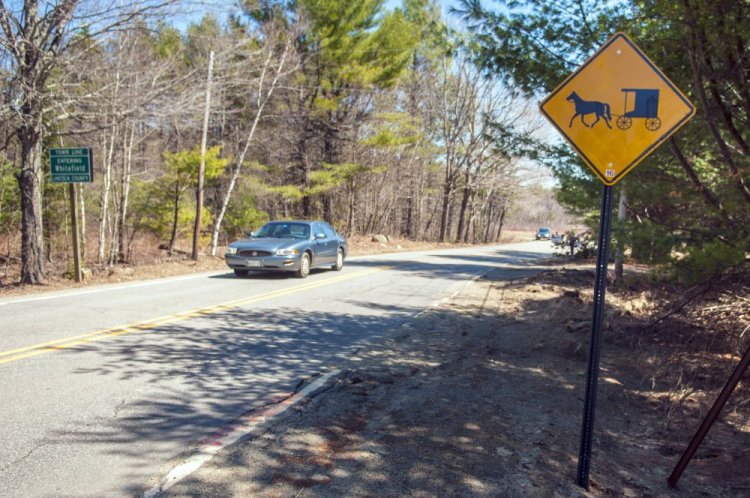State transportation officials on Wednesday handed out reflective armbands for Amish children who walk alongside the roads in Whitefield, a step intended to improve safety for the town’s newest residents.
Whitefield Select Board Chairman Tony Marple said the meeting between local officials and members of the Amish community included a healthy dialogue that will continue the conversation about how to make town roads safer for horse-drawn carriages and other vehicles.
“I feel confident we are having a good dialogue, but it’s still a dangerous situation,” Marple said. “We need to balance the need for safety with their desire to maintain their traditions.”
Marple said the Lincoln County Sheriff’s Office and the Maine Department of Transportation have been helpful in working with the town after two recent traffic accidents involving horse-and-buggy rigs.
A horse-drawn buggy was rear-ended Oct. 4, and there was also a minor accident on Sept. 28. Nobody was injured in either, but the accidents damaged the vehicles, including thousands of dollars in damage to the horse-drawn carriage. The incidents prompted the Select Board to begin talking about ways to make the town safer for its Amish residents.
After the October accident, the Select Board met with the sheriff’s office and DOT to think of ways to increase vehicle safety in Whitefield. The Select Board agreed to continue the discussion, and Marple said there are plans to meet with the Amish community again in November.
At Wednesday’s meeting, which Marple said lasted about 90 minutes, the Amish received reflective armbands from the state transportation department that their children could wear when walking on the sides of the roads. Marple said the group discussed making sure the children are walking on the side of the road facing oncoming traffic, especially when going to and leaving their school on Route 218.
Marple said the group also talked about adding signs on certain town roads in Whitefield, depending on where the Amish typically travel. He said the town has a better understanding of the Amish travelers’ routes, and the signs, if they are approved, would be placed accordingly.
The buggies have reflective tape on the backs so drivers of motor vehicles can see them. Marple said the group discussed other ways to make the carriages more visible, but it’s going to be a challenge.
“There is some reluctance among the Amish community, based on their tradition, to use electric lights,” he said.
Transportation department traffic engineer David Allen said the department would add mileage information — such as “Horse and Buggy next three miles” — under existing warning signs.
Chief Deputy Rand Maker said there is an electric information sign on East River Road, and the sheriff’s office plans to move it around Whitefield during the next few months in hope of alerting as many motorists as possible to the presence of horse-drawn carriages.
Marple said a second electric information sign will be placed on Route 218 to alert drivers about their speed.
“I think a lot of (the solution) will be community awareness,” he said. “It’s going to be an ongoing discussion, but we’re having a healthy dialogue.”
The Millers and at least two other Amish families moved into Whitefield and Jefferson in the spring after coming to Maine from New York state and Kentucky. Whitefield officials installed horse-and-buggy signs around town after their arrival.
Marple said there is still a lot to be done to educate residents and motorists. He said the Amish plan to submit an article for the Whitefield newsletter that also might be sent to local news media outlets.
The board also has discussed putting larger signs on specific roads entering the town that would read “Welcome to Whitefield. Beware of horse and buggy.” He said the cost for that type of sign would have to be included in the annual budget, but it is something they’ll look at next year.
Widening the roads is not something that has been discussed because it would be expensive, but Allen said he can’t say if that is something the DOT would consider in the future. Cooper Road doesn’t have a shoulder and Route 218, where the first accident occurred, doesn’t have much of one.
As more Amish people move into Whitefield and other central Maine communities, Marple said, discussions will continue on how best to make the busy thoroughfares, through streets and back roads safe for everyone.
Jason Pafundi — 621-5663
Twitter: @jasonpafundiKJ
Send questions/comments to the editors.



